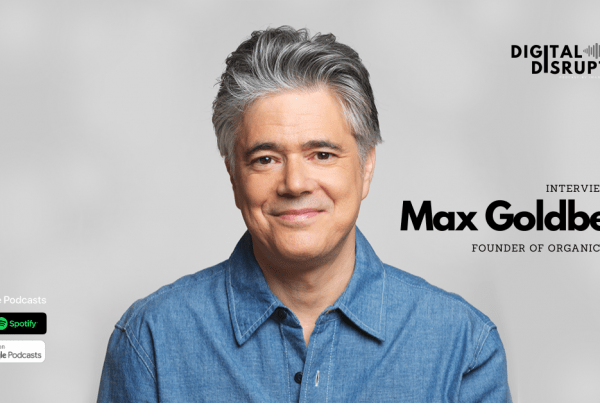Highlights
“Customer journey mapping is often regarded as an accessory marketing activity, but it’s actually a really crucial step in understanding the different triggers that inform the decision-making process. ”
Episode Transcript
Manuela
You’re listening to Digital Disrupted from IMS, the podcast series that looks at how the next Digital Trends are impacting you.
Manuela
Jeff Bezos from Amazon is known for stating the following: “We see our customers as invited guests to a party and we are the hosts. It’s our job every day to make every important aspect of the customer experience a little bit better.”
In this episode of digital disrupted, we are looking at three reasons why your customer experience strategy might be underperforming, and what to do about it.”
What’s the difference between “Customer Experience” and “Brand Experience”?
Celeste
Let’s start by defining customer experience. Customer Experience, also known as CX, is the result of every interaction a customer has with your business, from navigating your website to receiving the product.
Everything you do as a company impacts your customers’ perception of your brand and their decision to keep coming back or not. This means that a great customer experience is your key to success. We often hear now about brand experience as well, and I think it’s important to draw the difference.
Manuela
Brand experience encompasses the totality of all the interactions involved in the brand.
So the difference between brand experience and customer experience is that although both focus on the customer, the brand experience is about how a brand presents itself to all future customers, while the customer experience helps to guide that customer through their own personal journey with the brand.
Celeste
So essentially, brand experience is a more holistic view of the whole interaction between customer and the company.
Manuela
Right, exactly. So when you look at customer and brand experience, can you expand a little more on why customer experience is so important for companies?
Celeste
I think the reason why it matters so much is that you don’t know whether it’s a problem, until it becomes one. You might think you do have great customer experience but when a problem actually arises, that’s what makes the difference between what you’re delivering or not.
A great customer experience matters so much because it directly impacts customer loyalty. So if you want to turn your current customers into loyal customers who buy again from you, you need to focus on generating customer satisfaction and positive word-of-mouth. Positive reviews and recommendations are just a few indicators of whether you have a great customer experience or not.
Manuela
Given that we know what is at stake, can you give a couple of examples of brands who have either gotten customer experience right or wrong?
Examples of brands delivering poor or excellent customer experience
Celeste
Let’s start off with the negatives.
A few examples of what a bad Customer Experience could be, would be long waiting times (whether that’s customer service or delivery) or not understanding what it is that your customers need. Too much automation and not enough of the human touch can also negatively impact audience perception of your brand, as well as rude or poorly trained customer service agents.
I think an example that speaks to everyone that I think most of us remember was that 2017 United Airlines incident during which a passenger got dragged out of the plane. United Airlines took a hit on the stock market and their shares slipped by 4%. The company’s market value lost 2 billion USD and there were repercussions on social media as well.
An example of a brand delivering exceptional customer experience is Mercedes-Benz and their immersive User Guide, which is made with augmented reality. They created an app which allows you to scan any part of your car and find out more about it.
Another great example is the partnership created between Target and Pinterest. Together they created this visual search capability where customers can scan products and Pinterest will suggest similar products or products that would go well with an item that they’re interested in.
Manuela
Those are great examples. I just want to circle back on the United Airlines incident because that’s definitely an extreme level of the spectrum. It is important to note, however, that a neutral or underwhelming customer experience can be just as damaging. You don’t want to be forgotten by consumers!
Customer experience has a direct impact in how hard you have to work on your customer retention strategies or how hard you have to work as a brand to generate word-of-mouth, and a neutral customer experience that leaves your customers feeling lukewarm is not going to help build that long term brand success that all companies want to achieve.
Celeste
Right! And that’s where brands have the opportunities to differentiate themselves in similar spaces. Think of the small things that make a difference when ordering between two different e-commerce websites. If one offers you notifications, tracking, and regular updates – you’ll choose that one even though the products or pricing are similar.
Manuela
A key takeaway then is that in order to build up a good customer experience strategy, brands can start with the most basic things to cover the foundations of providing a smooth, pleasant positive customer experience, and then build from there to deliver extra value across the touchpoints that it offers.
Celeste
One of the first common mistakes companies make when trying to cover customer experience is not understanding the customer journey because they are not looking at all the touchpoints. In order to avoid that common pitfall, the solution is to map out your whole customer journey from the get-go.
Customer Journey Mapping: A crucial step in understanding what triggers decision-making
Manuela
Customer journey mapping is often regarded as an accessory marketing activity, but it’s actually a really crucial step in understanding the different triggers that inform the decision-making process.
This can range from big moments like making first purchases to smaller events like receiving an email or interacting with customer service. If you don’t understand consumers’ decision-making processes, you won’t be able to offer the right solutions or the right content that help you strengthen your connection with your consumers.
In order to be able to start with customer journey mapping, you need to start with data to be able to quantify your relationships with your customers.
Customer journey mapping also has other advantages, because it forces organizations to adopt the shifts that are necessary for a successful Customer Experience Program, such as getting teams to work together across different departments and also to be able to facilitate data sharing across these different departments.
As customer experience requires that these silos be broken down, customer journey mapping is a great first step to help prepare the right workflows for implementation. One common obstacle we see is data overwhelm: but the key is to start small and start with the data that you have.
Celeste, you mentioned to me earlier that customer journey mapping also helps take the guesswork out of thinking you know what your customers want? Can you expand on that?
Case study of Virgin Atlantic: Using data to validate customer experience assumptions
Celeste
Yes. It’s about putting yourself in the customers’ shoes and being customer centric. There is this great example of how Virgin Atlantic uses data gathering tools to validate the assumptions they were making about their experience.
Manuela
Their goal was to position themselves in a way where they would offer flight time as time well spent, and not just time wasted trying to get from A to Z, to cater for the experience-hungry generation.
They put together a team of strategists who actually went and spent time on flights, wearing wires that measured the impact of flying experiences on heart rate. Their goal was to prove that flying with Virgin Atlantic was a calmer and happier experience than flying with other airlines.
And they used these insights to revamp all their touchpoints including launching a new marketing campaign. Their initiatives led to an increase in how well consumers perceived the superior flying experience, and how good they felt.
The lesson here is that companies really need to put their ear to the ground and put themselves in the customers’ shoes, when it comes to understanding how consumers experience the brand.
Celeste
That’s a lot of airline examples for one day! Anyway, if you think that customer experience does not concern your brand, or your company, then let me just throw a few statistics from the CX Network, which surveyed 219 customer experience experts and found that 68% of marketers surveyed strongly believe customer expectations are rising. 47% believe it is getting harder to please customers and 49% say customer segments clearly preferred certain contact channels such as chat bots. And finally, 52% feel that customers are more likely to switch brands when unsatisfied.
Manuela
That’s so revealing and shows just how much there is at stake for brands when conducting customer experience mapping and when trying to build these customer experience strategies. It’s definitely not just about minimizing customer complaints.
Why should brands enhance their customer experience?
Celeste
It’s actually about driving revenue.
Manuela
I have a great example of a brand who successfully drove revenue from re-evaluating their customer experience. It is a children’s food brand called Ella’s kitchen.
It came onto the market in 2007 and by 2012, it had become the market leader in its category, and it had done so by challenging existing competitors with homestyle recipes and organic ingredients. They had also presented their children’s food in squeezable patches instead of the glass jars that their competitors were using at the time.
As competition increased, they recognized that they needed to improve the value that they were offering across touchpoints with parents to create deeper connections rather than just promoting their products or using discount pricing. But the problem with this category, of course, is that customers have a very short lifespan of less than two years, so constant lead acquisition is key.
When they did research into the needs of parents with children around this age category, they found that a critical time and a real pain point for parents is the weaning stage. Upon realizing that, they created additional customer touchpoints that specifically targeted weaning through an online program that uses data to personalize interactions and provide relevant experiences and content.
For the whole initiative, Ella’s Kitchen invested less than GBP 350,000 but generated GBP 14.6 million in revenue from it. And one of the most impressive statistics about this program is that about 40% of all UK parents entering the weaning phase with their children are recruited into the program, which is quite a feat! It’s really impressive.
The key takeaways here are that brands need to use insights to be able to address real customer needs in the journey, and understand how they can answer consumer needs in a way that is very genuine to the brand and in a way that adds great value for the consumer.
How can brands measure customer experience correctly? Data Analytics is the key.
Celeste
I think that just drives us to our second point, our second pitfall, if you will, which is how do you measure or do you measure your customer experience correctly?
We’re talking a lot about data, but if you are a company looking to lead a customer experience initiative, data usually lives in silos. So how do you reconcile or prioritize that data?
Manuela
Customer Experience initiatives are notoriously hard to measure. The problem is that measuring customer experience relies on having great data and credible analytics. So, to have a good customer experience strategy, you need to have a good data analytics strategy.
And one of the key difficulties, as you’ve just mentioned, is that with customer experience, you’re measuring a customer’s perception of your brand across an entire suite of touchpoints, which means that you need to be able to collect and integrate data across all of these touchpoints into different interactions with your brand, which typically are handled by different functions of your business or different teams.
Celeste
As an example, data that is handled by marketing or by sales may be treated or stored differently. If there is no communication on how those things are related to one another, you could be focusing on something but not getting the whole picture.
Manuela
So what we would usually recommend is that brands should start with what they have as a first step. Many customer experience projects are stalled because they require talents in data analytics programs and they require changes to workflows. They shouldn’t be put on hold because teams are waiting to implement fancy new technologies that may or may not receive the funding required for them to go ahead.
Instead, we propose identifying the quick wins that you can get started with the data and analytics that you already have. And then use these as proof of concept to accelerate implementation for newer, larger projects in the future.
Celeste
Let’s talk about the commonly used measuring tools of customer experience. We have the NPS Net Promoter Score, which is used to gauge customer satisfaction with a company product or service, or customers’ loyalty to a brand. We also have the customer satisfaction scores, which is usually measured by variations to a question on a customer feedback survey.
The difference between using the CSAT and the Net Promoter Score is that the former measures customer satisfaction with a product or service, whereas the latter measures customer loyalty to the organization.
And then the last commonly used measuring tool is the CES, the customer effort score. Once you have those three scores, you still need to be able to evaluate context of these results. This is because different consumers can have very subjective experiences of your brand.
The exact same customer experience for two people might actually be perceived very differently. These scores are good indicators but it’s best to supplement this information with qualitative data as well to get a more meaningful interpretation of these insights.
Manuela
Given the subjectivity of how a consumer might perceive its interaction with your brand, what would you say Celeste are the key things that a company can do to assure it has a reliable, holistic understanding of its customer experience?
Celeste
I think the keyword here, Manuela, is holistic. The data you collect from customers needs to be combined with other data sources too, such as Google Analytics, social media insights, and behavioral data. The idea is to group all of those different collection points into one central view to answer the question as to what you need to address first as a company, if you want to provide better customer experience as a whole.
Manuela
And the final thing that companies need to do in order to be able to put in place a measurement framework for their customer experience programs, is to be able to link all of those metrics back to business value.
That is what is going to help them get buy-in from the relevant decision makers. That is what’s going to sustain the momentum for these customer experience programs. And ultimately, that is what is going to enable the customer experience leaders or the CMOS to continue making the right decisions to continuously offer value to customers.
Celeste
This takes us back to our primary problem when trying to implement changes or initiatives in organizations. The bottom line is that CX strategies are typically a long-term initiative, yet most of the metrics used to measure the impact of these initiatives reflect short-term tactics. It’s critical for brands to be able to put in place a robust measurement framework that allows us to measure them.
Great employee experience leads to great customer experience
Manuela
On the subject of how an organization needs to align its internal team, a pivotal aspect of a successful Customer Experience Program is employee engagement. That leads us to a third key reason why customer experience programs tend to fail: how employees impact the customer experience.
And the steps needed to improve the employee experience is a key pillar to constructing a customer experience program that delivers business value.
Celeste
It all starts from within. You cannot expect a company to deliver exceptional customer experience if the employees themselves are not being delivered great employee experience. Let’s define these terms.
According to Gartner, employee engagement is defined as the extent to which a worker is willing to apply discretionary effort in order to achieve organizational goals and how he feels that the organization enables him as an employee to do his or her job.
Employee experience would be the perception of the work environment. So essentially what we are saying is that in order to get employee engagement that improves the customer experience in a positive way, organizations will need to set up an environment that allows for a very positive employee experience.
Celeste, are there any steps that we can talk about today that can help drive improvement in employee experience?
Celeste
Yes, I think the first thing that brands or companies need to remember is that your employees are essentially little brand ambassadors, right? They personify your brand culture and they’re the mouthpiece for your organization. If you are looking to improve your customer experience, have a look first at the conversations employees are having about your brand and your company.
That’s a very good first step in terms of companies that are able to drive both exceptional customer experience and employee experience. Decathlon is a great example of a company known for its standout employee experience. Its workforce is known for being dynamic and having opportunities to relocate to locations across the world. They also allow teams to exercise at any time of the day and there are other perks as well.
In terms of customer experience, Decathlon is a leader in digital transformation initiatives. Another great example is Google, which has topped Glassdoor’s list of Best Place to Work I think everyone knows some of the perks of being a Google employee: having on-site facilities, nap pods, prepared meals or vegan meals. But it’s not just about bottomless perks.
Going back to data, they actually have a very analytical approach to determine exactly what perk will make a difference. For example, they found that women about to have their first child had high resignation rates. HR put in place longer maternity leave to help increase retention and make them feel valued in the workplace.
Manuela
That’s a great example. And probably a relief to all brands listening that you don’t have to invest in sleep pods in order to create a great employee experience! I think you can summarize the employee experience initiative across three key pillars that you’ve covered with those case studies.
The first one is culture, which is about instilling a culture of customer centricity and how that translates to the employee experience.
The second one is technology, ensuring that employees have access to all the tools that are necessary for them to be able to do their job well.
And the third is physical. This is where those nap pods come in! But it’s the employee workspace: what is their working environment like? Is it conducive to them being able to become an ambassador for the brand and live and breathe the brand’s values?
Celeste
I think we have three main takeaways for this conversation.
The first one would be to start off by mapping out your customer journeys. This will allow you to identify quick wins or pain points.
The second pillar to consider will be to evaluate your data analytics and what’s available to you.
And thirdly, it’s to address the customer experience and to do so you need to start from within. So start with your employee experience, and how that translates into your customer experience.
Manuela
Thank you for listening to digital disrupted, it’s been a pleasure to be your hosts and you can find more great insights on our website at www.imanagesystems.com











